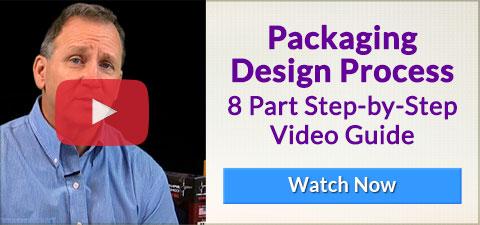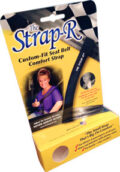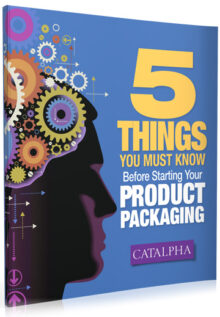10+ Tips to Creating Successful Packaging Design
Updated April 5, 2019
TIP 1: Know Your Customer!
This should be the ’number one‘ item on your list. Knowledge is power, right?
Who is your customer? It is the key that all other tips shown below are based on. We call this your Customer Persona. CP’s are a fictional, generalized description of your ideal customer.
Having a deep understanding of your customer will influence any decision you make about your product. Your packaging, tone of copy, coloring, marketing strategy, you name it.
Do your homework and find out who you are selling to. Is it a woman, 35+ age that likes to garden OR a man, 55+ that is a do-it-yourselfer?
Get to know your customer intimately. Know what their likes and dislikes are, their income level, their marital status, children and living location.
Knowing your core audience will make all other package design decisions easier.
The strongest personas are based on market research but they can be based on insight gleaned through customer interaction and interviews. Don’t have many customers yet? That’s OK, start small and add to it over time. Chances are your packaging will be updated in the future.
TIP 2: Are Your Product Benefits Prominently Displayed?
Many people focus on features to show how easy the product is to use or how good it tastes.
Instead, focus on what it does for the customer. That’s where your real selling power lies. Does it make them feel healthier, sexier, younger? Does it take away pain so they can do more physical work? Or does it save them time, so they can spend it with their children?
Get to the real meat of their desires and then work that into your packaging through content or imagery.
TIP 3: Consider Multiple Designs.
Don’t get stuck on one design. What you need is some objectivity. Look at multiple designs, print them out and set them next to each other.
What stands out? What catches your eye first? Get your family and friends involved—they are consumers too.
The bottom line is don’t think that just because YOU like it, your customer will too. Test, test, test.
TIP 4: Consider Your Price Point.
The cost of your product will influence your packaging choice and design. Don’t over design for a low price point product.
Over designing could mean higher packaging costs than necessary. Over designing could mean creating an expensive rigid box for a low cost item. The package looks and feels great but your packaging economics are upside down. There are other ways to include a unique look with out breaking the bank.
On the other side of that, if your product has a high price point, don’t skimp. Why do you think engagement rings come in plush velvet lined, rigid boxes? Or expensive liquor comes in a printed wooden box or a soft foam lined rigid box?
You’ll want to package it in a package that exudes refinement. Perhaps a unique fold out panel or raised / embossed foil stamp to give your customer a tactile feel.
TIP 5: Consider The Competition.
Did you do your due diligence and look at the competition? Did you actually visit the store(s) where your product will be sold?
If not, you’ll need to put that on your ‘to do’ list asap.
How will the product be displayed? On the shelf? On a peg hook? Next to each other? Take the time to shop the all stores you would like to see your product in and learn what the competition is doing.
Knowing the competition will help you rise above it. The better your upfront research, the more ammo you’ll have to do a better job.
Other questions that you might consider are:
Who’s package will yours sit next to? What colors are they using? You don’t want to design a package and then find out it uses the same color as the competition.
What style and size package do they use? Box, clamshell or stand up pouch?
How many flavor(s) do they sell in?
Is yours a small box and your competition is a large box with multiple pieces?
Will you have a series of products?
TIP 6: How Unique Is Your Package?
Will an interactive package help or hurt my chances in the aisle?
Your package may be too unique or unusual shape that stores don’t like to display it because it doesn’t stand easily on the shelf, or it can’t be stocked easily, etc.
Consider how the store will receive your product and get onto the shelf. Making it easier for them could translate into better sales for you.
TIP 7: Bag Or Box – Plastic Or Paper.
What to package your product in?—that is the question. The answer to that question is usually driven by price.
It’s a balance to package your product to its best advantage without adding too much to the cost.
Here are some guidelines…. Quantity and budget plays a major role in which type of package is best for your needs. Printing less than 1,000 paper cartons is usually economically unsound. If you want a custom plastic package, it’s impossible to print only 1,000. The start up costs for plastic include mold costs which range in the $1,000’s. And the minimum quantities are much higher, usually in the 10,000 – 15,000 range. PLUS, you’ll need to ship your product to the packager to be heat sealed into the package.
Large and heavy products that require a corrugate package also require a higher quantity if you want a full color retail package. Usually in the 5,000+ range. Because the best style corrugate printing is a litho-laminate style. That is printing a thin litho sheet (like a magazine style paper) and laminating that to corrugate. It looks great!, but you’ll have some higher start up costs associated with that such as plates, and cutting die on top of the printing cost.
TIP 8: Family Appearance.
Do you have more than one product? If so, your brand will be helped immensely by having a consistent brand look across all. Think of it as having one target on a wall of products vs having a section of targets on that wall. Which will give you much more attention in the aisle.
More than one product gives you a ‘combined’ billboard space and creates an ‘attention-grabbing’ visual area.
More attention equals more sales.
TIP 9: Consider Shopper Experience.
How will the shopper interact with your product? Can they touch it? Is your product completely sealed?
Is the store willing or encouraged to display one of your products out of the package?
If not, and your product’s selling point is a tactile feature, a die cut window may be appropriate.
Always think how your customers would want to shop your type of product. Do they need to see it? Touch it?
TIP 10: Think Of Your Package As A Shelf Billboard.
Make sure you have enough room on your package to show its benefits.
If your product is larger than a loaf of bread, then the chances are good you will have plenty of room to display features and benefits.
But if your product is small, including an area like a header will give you additional room to add selling copy and/or photos.
Here’s a BONUS: 5 More Tips To Help You Package It Right
TIP 11: Are You Starting A Brand?
A good package design will plan for the future.
If you have, or plan to have multiple skus (products), make sure your new packaging design can work across each package. If they are all the same size and style of package, that shouldn’t be a problem. But many times you have to package a short product, a thin product, etc.
Your brand should say family through color, typeface, and imagery.
Not only will multiple products make a more attractive offering to a store, but they will also command more attention in the aisle assuming your brand is consistent.
With a well designed package brand – you can just look at the package and tell whose brand it is.
TIP 12: Make It POP with color!
When you think of Black & Orange, what brand do you think of? What brand do you think of when I say Brown?
Consider a color that will help your product get noticed—and that could work into your brand as well.
Many companies dominate a color to help them stand out and create their brand. Take a look next time you are in the hardware store. What color are the power tools? Does the package color match the tool color?
Once you’ve established a color, your competitors will have a hard time using it since it will look too much like YOUR brand. That command of color takes time, but planning for it is the key.
TIP 13: Use Only The Words You Need To!
That means, keep your copy succinct and to the point.
Think of your text on your package like a Google Adword Ad—make the copy say the most with the least.
Consider photos or illustrations to describe your product or how to use your product.
Usually a cluttered packaging design leads to confusion and lost sales. Clarity is what you’re after. Remember those 3 seconds you have and make the most of them.
A good picture is worth a thousand words.
TIP 14: Quality Printing Is Important.
If you’ve gone the extra effort to work with a professional packaging designer, don’t skimp and try to print your package yourself unless you have previous experience. Usually this aspect of your packaging is taken into consideration at the beginning of your package journey. You and your designers should know where and how your package will be printed. It will go a long way to creating good results.
Take your finished design files to a quality printer of packages. Don’t go to the corner printer unless you know they have experience printing packages.
Just like package designers, there are printers that specialize in packaging as well.
The quality of the printing will be a reflection of the quality of your product.
TIP 15: Redesigns Of Existing Packaging Can Increase Sales Too
Many factors can dig into your products success. If you start suffering from lower sales, what could you attribute that too?
What about the competition? If you’re the industry leader, we’ve seen many competitors start to copy your packaging look. That dilutes it’s effectiveness. Perhaps there is category crowding or there’s been some industry upgrades. Tip #5 is something you should review periodically. Don’t be caught in the headlights, be prepared for the competition.
Perception, Perception, Perception!—It’s All About Perception.
In the aisle, you only have 3 seconds to catch the shopper’s attention and convey the benefits of your product over the competition.
In that short time, a shopper makes a decision about your product based on perception derived from what is presented—your package.
All the tips listed above come into play when designing your package.
Consider them wisely, and consider them all.
Don’t take our word, listen to what our clients have to say…

“Great! Thanks Karen. It was a real pleasure working with you and your team. Very professional. Great experience!”
Michael Bromberg, MVP Group

“I want to thank you so much for your quick turnaround on the patch design. It looks fantastic. You guys did a great job we love it, and our retail partner loves it. Looks great. Will have more work soon to send your way.”
Scott Davis, President
Contour Products





